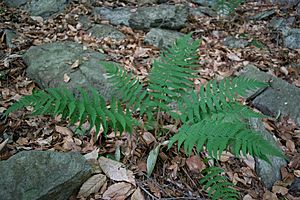Dryopteris marginalis facts for kids
Quick facts for kids Dryopteris marginalis |
|
|---|---|
 |
|
| Dryopteris marginalis growing in Bucks County Pennsylvania | |
| Conservation status | |
| Scientific classification | |
| Genus: |
Dryopteris
|
| Species: |
marginalis
|
 |
|
| Range within North America | |
| Synonyms | |
|
|
Dryopteris marginalis, also known as the marginal shield fern or marginal wood fern, is a type of fern that lives for many years. You can find it in wet, shady places across eastern North America. Its range stretches from Texas to Minnesota and Newfoundland. This fern prefers soil that is a bit acidic or neutral. Once it is established, it can handle dry periods quite well. In warmer areas, it often grows on north-facing rocks. You can see it in many different places, from high ledges to rocky slopes and stream banks. Its name comes from its sori (spore cases) being on the edges of its leaflets.
What it Looks Like
The marginal wood fern is an evergreen plant. This means its leaves stay green all year long! It is one of the few ferns that keeps its green leaves, like the Christmas fern.
This fern grows in a clump. It has a strong central root system. Sometimes, this root system can be seen. It might make the fern look like a tiny tree fern. Often, old, dead leaves gather under the plant.
The stipe, or stem that holds the leaf, is about one-fourth the length of the leaf. It is covered in bright golden-brown scales. The stipe has a groove on its upper side. It is dark red-brown at the bottom and turns green higher up.
The leaf is a dark blue-green color. It feels thick and leathery. It grows about 1 to 2 feet tall and 6 inches wide. Each leaf is divided into smaller parts called leaflets. These leaflets are arranged on both sides of the main stalk. The tips of these leaflets usually curve toward the tip of the leaf. These leaflets are also divided into even smaller parts called subleaflets. These subleaflets have blunt tips and are either jagged or lobed.
The fertile leaflets (those that hold spores) look similar to the other leaflets. The round sori (spore cases) are found on the edges of the leaf tissue. Before they are ready, the sori start gray. Then they turn an interesting blue-violet color. Finally, they turn brown when they are mature. The sori are covered by a smooth, kidney-shaped cover called an indusium.
Where it Grows
Dryopteris marginalis is found widely in the northeastern USA. It was first found in Minnesota in 1981. It was probably there for a long time but was missed. This was because it is rare there and looks very much like other ferns. In Minnesota, it is listed as a threatened species. This is not because it is in danger everywhere. It is because only one group of these ferns has been found there. This group grows on a bluff made of sandstone with limestone on top.
In other parts of its range, you can find it in many places. It grows in woods, on rocky slopes, and in rocky areas. It also grows on walls, wooded slopes, and ravines. You can also see it at the edges of woods, streams, and roads.
Growing it in Gardens
Dryopteris marginalis is a popular fern for gardens. It grows well in partial to full shade. It is an evergreen fern that does not spread out much. Instead, it forms a clump of leathery, deeply cut leaves that look like a vase. Gardeners use it in shade gardens, rock gardens, and native plant areas.
This fern usually does not have serious problems with insects or diseases. It can survive cold winters in many areas.
Dryopteris marginalis can also mix with 10 other fern species to form hybrids. Some of these hybrids are common. You can tell them apart because their spores are not perfectly formed. Also, their sori are not exactly on the edges of the leaves.
See also
 In Spanish: Dryopteris marginalis para niños
In Spanish: Dryopteris marginalis para niños







